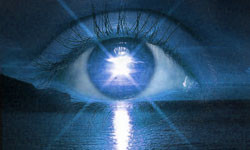Be Here
Blurry vision is well-known to be associated with intellectualism. But the way I see it, it has to do with a preference towards abstract ideas instead of being physically present. By being physically present, I mean being aware of the movement of your body, the feeling of your body, your breath, and the world immediately around you right now. It’s a matter of how much time you spend at either, or how often you take breaks to “ground” yourself when doing mentally intensive tasks on your computer or at your desk, or how much you stay physically present even while doing the mentally intensive tasks.
The most basic way of being present with what you’re doing is by focusing on something you already do anyway. You always have to breathe. So take one full minute, before you start this, to focus entirely on your breathing: the sound, rhythm, and feeling of your breath. Don’t think about anything else. Avoid thinking with any words and see if you can continue doing this for a full minute. Not so easy, is it? If you’re like most people, you’re used to living in your thoughts. While you focus on breathing for this long, do you find yourself trying to remember the experience of yourself a few moments ago, as if marveling that you could still exist without thinking?
If breathing itself isn’t enough to occupy you, you can also focus on your hands and what you’re touching with them, even if your fingers are touching nothing but the palms. Your hands help ground you physically in the same way as breathing grounds you. Your sense of touch is quite raw, or basic. It isn’t dressed up in fancy justifications and patterns. It’s real, unlike your thoughts.
The issue here is that your thoughts represent your programming repeating itself incessantly, affirming itself, and mixed up in your programming is your vision problems. By stopping your thoughts, for even just a moment, you stop your programming, and from that perspective you can better see what is really going on with yourself when you try to see. When your mind is silent, you see yourself better. So everything you do you notice for what it is. So you establish yourself as breath and as your hands. This is important because what you think of as “who you are” is a personality all wrapped up as part of your programming and vision problems. You’re rebuilding your programming in order to have a functional visual system (it isn’t as hard as it sounds), so you have to step outside of it a little, devalue it, and in your firm grounding in your breath be willing to toss away a little bit what you thought of as “who you are” if it isn’t congruent to the way your visual system is supposed to work.
Drive Yourself
So let’s get going.
In your attempt to see in a more natural way that leads to good vision, you may ironically be actually practicing a more mechanical and unnatural way of using your eyes than ever before. Some material on the Bates method tells you to shift between details, or trace outlines. But be careful about following an outline of an object, as if you’re drawing it with your eyes as the pencil. That isn’t how people with good vision see.
Remember that during this process you can spend time at things that do indirectly help your vision, such as palming, improving your back/neck posture, or conscious breathing. But when it comes to how to look at things, you don’t need to be practicing anything in your way of using your eyes that people with good vision don’t already do. And what they do is not hard. This process is really about backing up and understanding how simple seeing is supposed to be. You’ll beat yourself up when you finally realize that what you’ve been avoiding doing is the very key to seeing clearly.
We see lots of things to look at in the above photo. What’s the first thing you looked at? The house? Why? Maybe because at your first glance you decided it was the most significant thing there, or potentially the most interesting. The white color really stands out among the greens too. For our purposes it doesn’t matter why you looked at it. The thing to notice is the fact that your attention was drawn to it. And what’s something that people with good vision do. They look at what their attention is drawn to, or what is the most interesting thing at the moment.
I’m going over this in such small steps because blurry vision disorders are, in my opinion, caused by an attention disorder. You don’t spend enough time paying attention to what you’re looking at in the right way. To put it simplistically, I believe your eyes and your brain’s visual center aren’t working in unison, and your eyes can’t work well without your brain. And your own will has to be the starting point. You need a sincere desire to see something and find out more about it and devote your attention to it, or you’re just uselessly going through the motions. Your brain has to get involved and get fired up and stay that way.
 So let’s say you looked at the house. Why? Because for whatever reason you wanted to see it better. Now that we’re looking at the house, what’s the first part of the house you looked at? Nice railing on the porch. Is there anybody on the porch? What’s that on the door? I don’t see anybody on the porch, but what’s that sign in front of house? Beware of Dog? Parking in Rear? Can we see anything at all on the sign?
So let’s say you looked at the house. Why? Because for whatever reason you wanted to see it better. Now that we’re looking at the house, what’s the first part of the house you looked at? Nice railing on the porch. Is there anybody on the porch? What’s that on the door? I don’t see anybody on the porch, but what’s that sign in front of house? Beware of Dog? Parking in Rear? Can we see anything at all on the sign?
I’m only suggesting where you might look. I’m not telling you where to look, and you aren’t planning out where to look. So don’t get in the habit, when you’re practicing “shifting”, to just bounce around between points for the sake of keeping your eyes moving. The whole point of your eyes moving is it it signifies that your attention was moving and is driving your eyes to move as a consequence of you wanting to look more closely at different things.
What You Already See
With each object, look at the smallest details that you already can see. On the face of the sign, what’s the smallest piece of color you can perceive? And surely there are other spots elsewhere on the sign of the same size, so look around to notice some of them as well. Ok, so you’ve noticed what you can, and nothing else is apparent there, so you can look away from the sign and at the next most interesting thing. Easy, right? Makes sense that you have to do this to really see what you are already capable of seeing right now, right? And yet you don’t already do this, do you.
Don’t try to do anything to “bring out” the details that you think are there. You are simply using your vision, as it is in this moment, to its fullest extent, by looking at things the way you’re meant to. The more often you take a few seconds to hit your limit in the details you can see, the harder your brain works. When you keep looking for the smallest piece of color, occasionally you’ll notice even smaller pieces. Your brain will get the message loud and clear, and it will help you change your programming to perform this task all the time. Because it works. And it’s then that your programming serves you, and you are no longer at the mercy of what appears to be a dysfunctional system.
This is subtle stuff. Once you begin practicing this, you should notice that you have some trouble with it. Just make note of what you find yourself doing. Do you have a hard time becoming interested in seeing something else such that your attention is drawn to look at the smallest piece that you see? Do you find yourself looking away, closing your eyes, or otherwise taking a break to think for a moment about anything? This is your programming fighting against being disrupted. Do your best to keep yourself on track. You will fail countless times. And in the next moment you start over again. It’s a constant process of starting over. But each time you start over it means you never really failed.
get help on our Facebook Group!

I founded iblindness.org in 2002 as I began reading books on the Bates Method and became interested in vision improvement. I believe that everyone who is motivated can identify the roots of their vision problems and apply behavioral changes to solve them.

